Abstract
Activation-induced cell death (AICD) in T cells is mediated by CD95 ligand (CD95L)/receptor interaction, which has also been implicated in apoptosis induction by some anticancer agents. In this article we show that both anti-CD3-triggering (AICD) and doxorubicin treatment led to the production of a functionally active CD95L in the CD3+/T-cell receptor-positive (TCR+) T leukemia cell line H9. CD95L-expressing H9 cells killed CD95-sensitive J16 or CEM target cells, but not CD95-resistant CEM or J16 cells overexpressing dominant negative FADD (J16/FADD-DN). By immunoprecipitation, CD95L was physically bound to CD95, suggesting that AICD and doxorubicin-induced apoptosis involve CD95L-mediated CD95 aggregation, thereby triggering the CD95 death pathway. CD95 aggregation was associated with the recruitment of FADD and caspase-8 to the CD95 receptor to form the CD95 death-inducing signaling complex (DISC), resulting in caspase-8 activation and cleavage of the effector caspase-3 and PARP. Blocking of the CD95L/receptor interaction by antagonistic antibodies to CD95 or to CD95L also blocked AICD and inhibited the early phase of doxorubicin-induced apoptosis, though cell death induced by doxorubicin eventually proceeded in a CD95-independent manner. These findings may explain some conflicting data on the role of death receptor systems in drug-induced apoptosis. Thus, in cells with an inducible CD95 receptor/ligand system, drug-induced apoptosis may be mediated by CD95L-initiated DISC formation and activation of downstream effector programs similar to AICD in T cells. (Blood. 2000;95:301-308)
The CD95 system plays a key role in regulating the immune system, especially in T-cell homeostasis.1-7Activation-induced cell death (AICD) in activated T cells is mediated by CD95 ligand (CD95L)/receptor interaction.8 Stimulation of long-term activated T cells through the T-cell receptor (TCR)/CD3 complex induces the production of CD95L, which activates the CD95 pathway by binding to the CD95 surface receptor in an autocrine/paracrine fashion.8 Signaling through CD95 after ligand-dependent cross-linking of surface receptors requires the recruitment of FADD and caspase-8 into a death-inducing signaling complex (DISC).9-13 Caspase-8, an upstream component of the caspase cascade during death receptor-mediated apoptosis, is activated at the DISC and catalyzes the cleavage of downstream caspases.10,11 Activation of the CD95 death pathway by DISC formation has been found in many different cell types, including activated T cells (type 1 cells).14 However, in some cells CD95-induced death occurs in the absence of a detectable CD95 DISC (type 2 cells).14 The critical role of DISC-associated molecules, such as FADD and caspase-8 for CD95-induced apoptosis, has been confirmed in FADD or caspase-8 knockout mice in which the CD95 pathway is disabled in T cells.15-18
Releasing apoptogenic factors from mitochondria and caspase activation seems to be a key event in apoptosis induced by cytotoxic drugs.19,20 In addition, we and others21-28have suggested that the CD95L/receptor system is involved in drug-induced apoptosis in various cell types. Increased CD95 expression and induced CD95L on treatment with anticancer drugs such as doxorubicin was found to contribute to apoptosis by activating the CD95 death signaling pathway. However, the concept that the CD95 system may participate in drug-induced apoptosis has been challenged by several recent studies29-31 in which drug-induced apoptosis could not be blocked by putative antagonistic antibodies. In light of this controversy, we analyzed and compared the early events of activation of the CD95 system in AICD and doxorubicin-induced apoptosis in H9 cells.
We describe for the first time that doxorubicin treatment or TCR/CD3 engagement leads to the formation of a CD95L-containing DISC. Furthermore, functionally active CD95L was found that mediated the direct killing of CD95-sensitive cells. Because interfering with CD95L/receptor interaction inhibited AICD and doxorubicin-induced apoptosis, these findings suggest that CD95L-mediated CD95 DISC formation and activation of downstream apoptosis programs are involved in the early phase of drug-induced apoptosis similar to AICD in certain cell types.
Materials and methods
Drugs
Doxorubicin (Farmitalia, Milano, Italy) was provided as a pure substance and was dissolved in sterile water. OKT3 antibody was produced using the murine hybridoma cell line OKT3 (American Type Culture Collection, Rockville, MD). For plate coating, OKT3 antibody was used at 100 μg/mL.
Cell culture
CD3+ and CD3- subclones of the human T leukemia cell line H9, CEM, and J16 cells were maintained in suspension culture in 75 cm2 tissue culture flasks (Falcon, Heidelberg, Germany) in RPMI 1640 medium (Life Technologies, Eggenstein, Germany) supplemented with 10% heat inactivated fetal calf serum (FCS) (Conco, Wiesbaden, Germany), 10 mM HEPES, pH 7.4 (Biochrom, Berlin, Germany), 100 U/mL penicillin (Life Technologies), 100 μg/mL streptomycin (Life Technologies), and 2 mmol/L L-glutamine (Biochrom) and incubated at 37°C in 95% air/5% CO2. pcDNA3 containing death domain-deleted FADD (clone NFD432) was transfected by lipofection into J16 cells (J16/FADD-DN), and transfectants were subcloned and cultured in RPMI 1640 medium containing 0.5 mg/mL geneticin (Life Technologies). CD95-resistant cell variants of CEM cells (CApoR) were generated and cultured as previously described.27 Then 0.5–1 × 105 cells/mL were cultured in 96-well plates for the determination of apoptosis and in 75-cm2 tissue culture flasks for RNA and protein isolation or immunoprecipitation.
Determination of apoptosis
Cells were incubated for indicated times with doxorubicin or on plates precoated with 100 μg/mL OKT3. Quantification of DNA fragmentation was performed by fluorescence-activated cell-sorting analysis of propidium iodide-stained nuclei, as previously described33 using CELLQuest software (Becton Dickinson, Heidelberg, Germany).
Inhibition of apoptosis by Fab anti-CD95 antibody fragments or anti-CD95L antibody Nok-1
Fab anti-CD95 antibody fragments8 were used at 50 μg/mL, and anti-CD95L antibody Nok-1 (PharMingen, Hamburg, Germany) was used at 100 μg/mL.
Reverse transcription-polymerase chain reaction for CD95-L mRNA
Total RNA was prepared using the Qiagen total RNA kit (Qiagen, Hilden, Germany). RNA was converted to cDNA by reverse transcription and amplified for 38 cycles by polymerase chain reaction in a thermocycler (Stratagene, Heidelberg, Germany) using the Gene Amplification RNA-PCR kit (Perkin Elmer, Branchburg, NJ) according to the manufacturer's instructions. A 500-bp fragment of CD95-L was amplified using primer 5′ATGTTTCAGCTCTTCCACCTACAGA3′ and 5′CCAGAGAGAGCTCAGATACGTTGAC3′. Expression of β-actin (MWG; Biotech, Ebersberg, Germany) was used as a standard for RNA integrity and equal gel loading. Polymerase chain reaction products were run at 60 V for 2 hours on a 1.5% agarose gel stained with ethidium bromide and visualized by ultraviolet illumination.
Western blot analysis
Cells were lysed for 30 minutes at 4°C in phosphate-buffered saline with 0.5% Triton X (Serva, Heidelberg, Germany) and 1 mmol/L phenylmethylsulfonyl fluoride (Sigma, Deisenhofen, Germany) and then underwent high-speed centrifugation. Membrane proteins were eluted in buffer containing 0.1 mol/L glycine, pH 3.0, and 1.5 mol/L Tris, pH 8.8. Protein concentration was assayed using bicinchoninic acid (Pierce, Rockford, IL); 40 μg protein per lane was separated by 12% or 15% sodium dodecyl sulfate–polyacrylamide gel electrophoresis (SDS-PAGE) and electroblotted onto nitrocellulose (Amersham, Braunschweig, Germany). Equal protein loading was controlled by Ponceau red staining of membranes. After blocking for 1 hour in phosphate-buffered saline supplemented with 2% bovine serum albumin (Sigma) and 0.1% Tween 20 (Sigma), immunodetection of FADD, caspases-3 and -8, CD95, CD95L, and PARP was achieved using mouse anti-caspase-8 monoclonal antibody (mAb) C15 (1:5 dilution of hybridoma supernatant13), mouse anti-caspase-3–specific mAb (1:1000; Transduction Laboratories, Lexington, KY), mouse anti-CD95 mAb (1:1000; Transduction Laboratories), mouse anti-CD95L mAb (1:250, PharMingen), rabbit anti-PARP polyclonal antibody (1:10 000; Enzyme Systems Products), or mouse anti-FADD mAb (1:500; Transduction Laboratories). Goat antimouse IgG or goat antirabbit IgG (1:5000; Santa Cruz Biotechnology) followed by electrochemiluminescence (Amersham) was used for detection. Specificity of bands on Western blots was identified by molecular weight markers. For CD95L, specificity of bands was also determined by recombinant CD95L and by using cells transfected with CD95L as a positive control.
Immunoprecipitation
Cells were treated with 0.1 μg/mL doxorubicin or incubated in flasks precoated with 100 μg/mL OKT3 and lysed. Immunoprecipitation of the CD95 DISC was performed as previously described9 14using mouse anti-APO-1 IgG3 monoclonal antibody and protein A sepharose (Sigma). Beads were washed 3 times in lysis buffer, and proteins were separated on 12% SDS-PAGE. Westerns blot for FADD, caspase-8, and CD95L protein was performed as described above.
CD95 aggregation
CD95 aggregation was assessed by immunoprecipitating CD95 at the limiting antibody concentration of 0.5 μg/mL or at the excess concentration of 2 μg/mL mouse anti-APO-1 IgG3 monoclonal antibody, as previously described.34
Coculture experiments
H9 cells were stimulated with 0.1 μg/mL doxorubicin or 100 μg/mL OKT3, washed 3 times, and cocultured with J16, J16/FADD-DN, CEM, or CD95-resistant CEM cells (CApoR). Target cells were stained with calcein (5 ng/mL; Molecular Probes, Eugene, OR) before coculture. Apoptosis was assessed in the calcein-stained target cell population by FSC/side scatter (SSC) analysis.
Results
Induction of functionally active CD95L on treatment with doxorubicin or OKT3
For all experiments we used a CD3+ chemosensitive human T leukemia cell line (H9) in which activation-induced death could be triggered by anti-CD3 stimulation. Triggering of the TCR/CD3 complex by immobilized OKT3 antibody resulted in apoptosis in CD3+ H9 cells, whereas minimal apoptosis was induced in CD3- H9 cells (Figure1A, upper panel). Doxorubicin induced apoptosis in H9 cells in a dose- and time-dependent manner as assessed by DNA fragmentation (Figure 1A, lower panel). Apoptosis was also determined by Annexin V, staining leading to similar results (data not shown). Treatment of H9 cells with 0.003–0.1 μg/mL doxorubicin induced maximal CD95L mRNA and protein expression at 2 to 6 hours, well before the onset of apoptosis (Figures 1B, 1C). Similarly, stimulation of TCR by OKT3 resulted in the upregulation of CD95L mRNA and protein in CD3+ but not in CD3- H9 cells (Figure 1B).
Doxorubicin- or OKT3-induced apoptosis and CD95L expression.
(A) Doxorubicin- or OKT3-induced apoptosis. (upper panel) CD3+ (▪) or CD3- (□) H9 cells were incubated for the time points indicated on 96-well plates precoated with 100 μg/mL OKT3. (lower panel) CD3+ H9 cells were treated with doxorubicin (▪, 0.003 μg/mL; □, 0.01 μg/mL; x, 0.03 μg/mL; ○, 0.1 μg/mL; ■, 0.3 μg/mL). Apoptosis was determined by fluorescence-activated cell-sorting analysis of propidium iodide-stained DNA content. Percentage of specific apoptosis was calculated as follows: 100 × (experimental apoptosis [%] − spontaneous apoptosis [%]/100% − spontaneous apoptosis [%]). Data are the mean of triplicates; similar results were obtained in 3 separate experiments. (B) Doxorubicin- or OKT3-induced CD95 ligand expression. CD3+ H9 cells were treated with 0.1 μg/mL doxorubicin for the time points indicated. CD3+ or CD3− H9 cells were incubated for 6 hours in 75-cm2 flasks precoated with 100 μg/mL OKT3. CD95-L mRNA expression was determined by reverse transcription–polymerase chain reaction. Expression of β-actin was used to control RNA integrity and equal gel loading. For Western blot analysis, 40 μg cell lysate protein per lane was separated by 12% sodium dodecyl sulfate–polyacrylamide gel electrophoresis (SDS-PAGE). CD95-L protein was detected as 40 kD band by mouse anti-CD95-L monoclonal antibody (clone G247-4) and ECL. Expression of tubulin was used to control equal protein loading. (C) Dose response of doxorubicin-induced CD95 ligand expression. CD3+ H9 cells were treated with 0.003-0.1 μg/mL doxorubicin for 6 hours. 40 μg protein of cell lysates per lane were separated by 12% SDS-PAGE. CD95-L protein was detected as 40 kD band by mouse anti-CD95-L monoclonal antibody (clone G247-4) and ECL.
Doxorubicin- or OKT3-induced apoptosis and CD95L expression.
(A) Doxorubicin- or OKT3-induced apoptosis. (upper panel) CD3+ (▪) or CD3- (□) H9 cells were incubated for the time points indicated on 96-well plates precoated with 100 μg/mL OKT3. (lower panel) CD3+ H9 cells were treated with doxorubicin (▪, 0.003 μg/mL; □, 0.01 μg/mL; x, 0.03 μg/mL; ○, 0.1 μg/mL; ■, 0.3 μg/mL). Apoptosis was determined by fluorescence-activated cell-sorting analysis of propidium iodide-stained DNA content. Percentage of specific apoptosis was calculated as follows: 100 × (experimental apoptosis [%] − spontaneous apoptosis [%]/100% − spontaneous apoptosis [%]). Data are the mean of triplicates; similar results were obtained in 3 separate experiments. (B) Doxorubicin- or OKT3-induced CD95 ligand expression. CD3+ H9 cells were treated with 0.1 μg/mL doxorubicin for the time points indicated. CD3+ or CD3− H9 cells were incubated for 6 hours in 75-cm2 flasks precoated with 100 μg/mL OKT3. CD95-L mRNA expression was determined by reverse transcription–polymerase chain reaction. Expression of β-actin was used to control RNA integrity and equal gel loading. For Western blot analysis, 40 μg cell lysate protein per lane was separated by 12% sodium dodecyl sulfate–polyacrylamide gel electrophoresis (SDS-PAGE). CD95-L protein was detected as 40 kD band by mouse anti-CD95-L monoclonal antibody (clone G247-4) and ECL. Expression of tubulin was used to control equal protein loading. (C) Dose response of doxorubicin-induced CD95 ligand expression. CD3+ H9 cells were treated with 0.003-0.1 μg/mL doxorubicin for 6 hours. 40 μg protein of cell lysates per lane were separated by 12% SDS-PAGE. CD95-L protein was detected as 40 kD band by mouse anti-CD95-L monoclonal antibody (clone G247-4) and ECL.
To investigate whether CD95L, induced on treatment with doxorubicin or OKT3, was functionally active, we performed coculture experiments using CD95-sensitive or -resistant target cells. Doxorubicin-treated H9 cells induced apoptosis in CD95-sensitive J16 cells, but untreated cells did not (Figure 2A). Apoptosis induced by doxorubicin-treated H9 cells was reduced in J16 cells harboring FADD-DN (Figure 2A). Similarly, apoptosis triggered by doxorubicin-treated H9 cells, in comparison with CD95-sensitive CEM cells, was inhibited in variant CEM cells resistant to CD95-triggered apoptosis (Figure2A). Furthermore, H9 cells induced to express CD95L by OKT3 treatment efficiently triggered apoptosis in J16 cells, but this was less efficient in J16 cells harboring FADD-DN (Figure 2B). Apoptosis by OKT3-treated H9 cells was also induced in CD95-sensitive CEM cells, but not in CD95-resistant CEM cells (Figure 2B).
Induction of functionally active CD95 ligand by doxorubicin or OKT3.
(A) Induction of apoptosis by doxorubicin-treated H9 cells in J16 or CEM target cells is inhibited in J16/FADD-DN and in CD95-resistant CEM target cells. CD3+ H9 cells were treated with 0.1 μg/mL doxorubicin for 6 hours, washed, and cocultured for 24 hours with calcein-stained J16, J16/FADD-DN, CEM, or CD95-resistant CEM (CApoR) cells. Apoptosis in calcein-stained target cells was determined by FSC/SSC analysis. (B) Induction of apoptosis by OKT3-treated H9 cells in J16 or CEM target cells is inhibited in J16/FADD-DN and in CD95-resistant CEM target cells. CD3+ H9 cells were incubated for 6 hours in 75 cm2flasks precoated with 100 μg/mL OKT3, washed, and cocultured with calcein-stained J16, J16/FADD-DN, CEM, or CD95-resistant CEM (CApoR) cells. Apoptosis in calcein-stained target cells was determined by FSC/SSC analysis. (C) Induction of apoptosis by doxorubicin or OKT3-treated H9 cells in J16 target cells is inhibited by Fab anti-CD95 antibody fragments or by anti-CD95L antibody. CD3+ H9 cells were treated for 6 hours with 0.1 μg/mL doxorubicin or were incubated for 6 hours in 75 cm2 flasks precoated with 100 μg/mL OKT3, washed, and cocultured with calcein-stained J16 cells in the presence or absence of 50 μg/mL Fab anti-CD95 antibody fragments or 100 μg/mL Nok-1 antibody. Apoptosis in calcein-stained target cells was determined by FSC/SSC analysis. (D) Lack of apoptosis by doxorubicin-treated Nalm6 cells in J16 or CEM target cells. Nalm6 cells were treated for 6 hours with 0.1 μg/mL doxorubicin, washed, and cocultured with calcein-stained J16, J16/FADD-DN, CEM, or CD95-resistant CEM (CApoR) cells. Apoptosis in calcein-stained target cells was determined by FSC/SSC analysis.
Induction of functionally active CD95 ligand by doxorubicin or OKT3.
(A) Induction of apoptosis by doxorubicin-treated H9 cells in J16 or CEM target cells is inhibited in J16/FADD-DN and in CD95-resistant CEM target cells. CD3+ H9 cells were treated with 0.1 μg/mL doxorubicin for 6 hours, washed, and cocultured for 24 hours with calcein-stained J16, J16/FADD-DN, CEM, or CD95-resistant CEM (CApoR) cells. Apoptosis in calcein-stained target cells was determined by FSC/SSC analysis. (B) Induction of apoptosis by OKT3-treated H9 cells in J16 or CEM target cells is inhibited in J16/FADD-DN and in CD95-resistant CEM target cells. CD3+ H9 cells were incubated for 6 hours in 75 cm2flasks precoated with 100 μg/mL OKT3, washed, and cocultured with calcein-stained J16, J16/FADD-DN, CEM, or CD95-resistant CEM (CApoR) cells. Apoptosis in calcein-stained target cells was determined by FSC/SSC analysis. (C) Induction of apoptosis by doxorubicin or OKT3-treated H9 cells in J16 target cells is inhibited by Fab anti-CD95 antibody fragments or by anti-CD95L antibody. CD3+ H9 cells were treated for 6 hours with 0.1 μg/mL doxorubicin or were incubated for 6 hours in 75 cm2 flasks precoated with 100 μg/mL OKT3, washed, and cocultured with calcein-stained J16 cells in the presence or absence of 50 μg/mL Fab anti-CD95 antibody fragments or 100 μg/mL Nok-1 antibody. Apoptosis in calcein-stained target cells was determined by FSC/SSC analysis. (D) Lack of apoptosis by doxorubicin-treated Nalm6 cells in J16 or CEM target cells. Nalm6 cells were treated for 6 hours with 0.1 μg/mL doxorubicin, washed, and cocultured with calcein-stained J16, J16/FADD-DN, CEM, or CD95-resistant CEM (CApoR) cells. Apoptosis in calcein-stained target cells was determined by FSC/SSC analysis.
To explore the specific involvement of the CD95 system, we performed blocking experiments. Apoptosis in J16 cells was markedly inhibited when they were cocultured with doxorubicin- or OKT3-treated H9 cells in the presence of anti-APO-1-Fab antibody fragments or CD95L antibody (Figure 2C). These results indicated that CD95L, induced in H9 cells on treatment with doxorubicin or OKT3, was involved in mediating apoptosis in CD95-sensitive target cells. To exclude the effect of these coculture experiments caused by the doxorubicin efflux of drug-treated cells, we used doxorubicin-treated Nalm6 cells instead of H9 cells for coculture experiments. Nalm6 cells do not upregulate CD95L on doxorubicin treatment. However, compared with H9 cells, they readily undergo apoptosis in response to doxorubicin and show a similar doxorubicin efflux (data not shown). Incubation of doxorubicin-treated Nalm6 cells with J16 or CEM cells did not trigger apoptosis in target cells (Figure 2D), indicating that the observed effect is probably caused by CD95L/receptor interaction between target and effector cells. Taken together, these coculture experiments suggest that the treatment of H9 cells with doxorubicin or OKT3 resulted in the expression of functionally active CD95L in these cells.
CD95L-mediated death-inducing signaling complex formation and activation of caspases on treatment with doxorubicin or OKT3
It is thought that CD95L mediates apoptosis in an autocrine/paracrine manner by triggering CD95. Therefore, we explored whether CD95L was physically bound to the CD95 receptor. On treatment with doxorubicin, CD95L was immunoprecipitated in association with CD95 (Figure 3A). It was also detected in association with CD95 when CD3+ H9 cells were treated with OKT3, but not when CD3- H9 cells that did not express CD95L on OKT3 treatment were used (Figure 3A). Thus, CD95L induced on doxorubicin or OKT3 treatment binds to CD95, triggering the CD95 pathway. Because CD95 has been reported to oligomerize on activation, we next asked whether binding of CD95L to CD95 would result in CD95 aggregation. To address this, we analyzed CD95 aggregation by immunoprecipitating CD95 under limiting antibody concentration.34 Under these conditions, CD95 is precipitated significantly only when receptors are cross-linked. In the absence of CD95 aggregation, the antibody will bind to single receptors only, which results in undetectable amounts of precipitated CD95. Using limited antibody concentrations, cross-linked CD95 was found on doxorubicin treatment but not in untreated control cells (Figure 3B). Using excess antibody concentrations, CD95 was detected similarly in treated and untreated cells (Figure 3B).
Doxorubicin- or OKT3-induced DISC formation and activation of caspases.
(A) Detection of DISC-bound CD95 ligand. CD3+ H9 cells were treated with 0.1 μg/mL doxorubicin for the time points indicated. CD3+ or CD3-H9 cells were incubated for 6 hours in 75 cm2 flasks precoated with 100 μg/mL OKT3. Cells were lysed and immunoprecipitation of CD95 was performed by FADD monoclonal antibody. Proteins were separated by 12% sodium dodecyl sulfate–polyacrylamide gel electrophoresis (SDS-PAGE). CD95-L protein was detected by mouse anti-CD95-L monoclonal antibody and ECL. (B) Doxorubicin- induced CD95 aggregation. CD3+ H9 cells were treated with 0.1 μg/mL doxorubicin for the time points indicated. Cells were lysed, and immunoprecipitation of CD95 was performed by anti-APO-1 IgG3 monoclonal antibody using limiting antibody concentrations (0.5 μg/mL) or excess antibody concentrations (2 μg/mL). Proteins were separated by 12% SDS-PAGE. CD95 protein was detected by mouse anti-CD95 monoclonal antibody and ECL. (C) Doxorubicin, OKT3-, or anti-APO-1–induced DISC formation. CD3+ H9 cells were treated with 0.1 μg/mL doxorubicin for the time points indicated or with 1 μg/mL anti-APO-1 IgG3 monoclonal antibody for 15 minutes. CD3+ or CD3-H9 cells were incubated for 6 hours in 75 cm2 flasks precoated with 100 μg/mL OKT3. Cells were lysed, and immunoprecipitation of CD95 was performed by anti-APO-1 IgG3 monoclonal antibody (I.P.) or Western blot analysis was performed (blot). Proteins were separated by 12% SDS-PAGE. FADD and caspase-8 protein were detected by mouse anti-FADD monoclonal antibody or mouse anti-caspase-8 monoclonal antibody and ECL. (D) Dose response of doxorubicin-induced DISC formation. CD3+ H9 cells were treated with 0.03-0.3 μg/mL doxorubicin for 12 hours. Immunoprecipitation of the CD95 DISC was performed as described in Figure 3C. (E) Doxorubicin- or OKT3-induced activation of caspases. CD3+ H9 cells were treated with 0.1 μg/mL doxorubicin for the time points indicated. CD3+ or CD3-H9 cells were incubated for 6 hours in 75 cm2 flasks precoated with 100 μg/mL OKT3. Western blot analysis for caspase-8, caspase-3, or PARP protein was performed using mouse anti-caspase-8 monoclonal antibody, mouse anti-caspase-3 monoclonal antibody, or rabbit anti-PARP polyclonal antibody and ECL. Processing of caspase-8, which was detected as a double band corresponding to 2 caspase-8 isoforms (caspase-8/a and caspase-8/b), resulted in p43 and p41 cleavage intermediates derived from caspase-8/a and caspase-8/b, respectively, and the p18 active subunit.
Doxorubicin- or OKT3-induced DISC formation and activation of caspases.
(A) Detection of DISC-bound CD95 ligand. CD3+ H9 cells were treated with 0.1 μg/mL doxorubicin for the time points indicated. CD3+ or CD3-H9 cells were incubated for 6 hours in 75 cm2 flasks precoated with 100 μg/mL OKT3. Cells were lysed and immunoprecipitation of CD95 was performed by FADD monoclonal antibody. Proteins were separated by 12% sodium dodecyl sulfate–polyacrylamide gel electrophoresis (SDS-PAGE). CD95-L protein was detected by mouse anti-CD95-L monoclonal antibody and ECL. (B) Doxorubicin- induced CD95 aggregation. CD3+ H9 cells were treated with 0.1 μg/mL doxorubicin for the time points indicated. Cells were lysed, and immunoprecipitation of CD95 was performed by anti-APO-1 IgG3 monoclonal antibody using limiting antibody concentrations (0.5 μg/mL) or excess antibody concentrations (2 μg/mL). Proteins were separated by 12% SDS-PAGE. CD95 protein was detected by mouse anti-CD95 monoclonal antibody and ECL. (C) Doxorubicin, OKT3-, or anti-APO-1–induced DISC formation. CD3+ H9 cells were treated with 0.1 μg/mL doxorubicin for the time points indicated or with 1 μg/mL anti-APO-1 IgG3 monoclonal antibody for 15 minutes. CD3+ or CD3-H9 cells were incubated for 6 hours in 75 cm2 flasks precoated with 100 μg/mL OKT3. Cells were lysed, and immunoprecipitation of CD95 was performed by anti-APO-1 IgG3 monoclonal antibody (I.P.) or Western blot analysis was performed (blot). Proteins were separated by 12% SDS-PAGE. FADD and caspase-8 protein were detected by mouse anti-FADD monoclonal antibody or mouse anti-caspase-8 monoclonal antibody and ECL. (D) Dose response of doxorubicin-induced DISC formation. CD3+ H9 cells were treated with 0.03-0.3 μg/mL doxorubicin for 12 hours. Immunoprecipitation of the CD95 DISC was performed as described in Figure 3C. (E) Doxorubicin- or OKT3-induced activation of caspases. CD3+ H9 cells were treated with 0.1 μg/mL doxorubicin for the time points indicated. CD3+ or CD3-H9 cells were incubated for 6 hours in 75 cm2 flasks precoated with 100 μg/mL OKT3. Western blot analysis for caspase-8, caspase-3, or PARP protein was performed using mouse anti-caspase-8 monoclonal antibody, mouse anti-caspase-3 monoclonal antibody, or rabbit anti-PARP polyclonal antibody and ECL. Processing of caspase-8, which was detected as a double band corresponding to 2 caspase-8 isoforms (caspase-8/a and caspase-8/b), resulted in p43 and p41 cleavage intermediates derived from caspase-8/a and caspase-8/b, respectively, and the p18 active subunit.
We next explored whether drug-induced CD95 aggregation resulted in triggering of the CD95 pathway. On treatment with 0.03 to 0.3 μg/mL, doxorubicin or OKT3 FADD and caspase-8 were recruited to CD95 to form the CD95 DISC, and there were no changes in expression levels of FADD or caspase-8 (Figures 3C, 3D). Similarly, FADD and caspase-8 were recruited to CD95 after CD95 triggering and on OKT3 treatment in CD3+ cells but not in CD3- H9 cells (Figure 3C). These results suggest that CD95 receptor aggregation on CD95L binding may initiate the CD95 death-signaling pathway. With doxorubicin or OKT3 treatment, caspase-8, caspase-3, and PARP were cleaved, indicating that CD95 aggregation and DISC formation resulted in full activation of the CD95 apoptosis pathway (Figure 3E).
Inhibition of doxorubicin- or OKT3-induced apoptosis by antagonistic antibody to CD95 or CD95L
To continue to explore whether CD95L/receptor interaction was similarly involved in AICD and drug-induced apoptosis, we conducted blocking experiments. Blocking CD95L/receptor interaction using Fab anti-APO-1 antibody fragments or CD95L antibody inhibited OKT3-triggered apoptosis and reduced doxorubicin-induced apoptosis in the early stages (Figures 4A, 4B), suggesting that death mechanisms independent of CD95L/receptor interaction may also be involved after prolonged exposure to doxorubicin.
Reduction of doxorubicin- or OKT3-induced apoptosis by Fab anti-CD95 antibody fragments or anti-CD95L antibody. CD3+ H9 cells were treated with 0.1 μg/mL doxorubicin (A) or CD3+ or CD3-H9 cells were incubated for 6 hours in 75 cm2 flasks precoated with 100 μg/mL OKT3 (B) for 24 hours or 48 hours in the absence (black bars) or presence (white bars) of 50 μg/mL Fab anti-CD95 antibody fragments or 100 μg/mL anti-CD95L antibody Nok-1. Apoptosis was determined as described in Figure 1.
Reduction of doxorubicin- or OKT3-induced apoptosis by Fab anti-CD95 antibody fragments or anti-CD95L antibody. CD3+ H9 cells were treated with 0.1 μg/mL doxorubicin (A) or CD3+ or CD3-H9 cells were incubated for 6 hours in 75 cm2 flasks precoated with 100 μg/mL OKT3 (B) for 24 hours or 48 hours in the absence (black bars) or presence (white bars) of 50 μg/mL Fab anti-CD95 antibody fragments or 100 μg/mL anti-CD95L antibody Nok-1. Apoptosis was determined as described in Figure 1.
Discussion
The CD95L/receptor system has been shown to mediate TCR/CD3-induced AICD in T cells.1-3,8 As in T-cell activation, drug-induced apoptosis of cancer cells was found to involve the CD95 system, at least in some cells.21-28 In this study we showed that functionally active CD95L was induced with doxorubicin or OKT3 treatment in the CD3/TCR+ T leukemia cell line H9 and that it efficiently mediated apoptosis in CD95-sensitive J16 or CEM target cells, whereas CD95L-mediated apoptosis was reduced in CD95-resistant CEM or FADD-DN overexpressing J16 cells. In doxorubicin-treated cells or in cells undergoing AICD, CD95L was physically bound to CD95, suggesting that CD95L- initiated the formation of the most upstream components of the CD95 death- signaling pathway. Doxorubicin- or OKT3-induced CDD95 aggregation was associated with the recruitment of FADD and caspase-8 to the CD95 receptor to form the CD95 DISC, resulting in caspase-8 activation and cleavage of the effector caspase-3 and PARP. If antagonistic antibodies to CD95 or CD95L interfered with the binding of CD95L to CD95, it inhibited AICD and reduced drug-mediated apoptosis.
Doxorubicin-induced CD95L expression and death-inducing signaling complex formation similar to AICD
This is the first report to identify that CD95L was physically bound to CD95 on the induction of AICD or drug-induced apoptosis. Our findings demonstrated that CD95 DISC formation could be induced by the physiological ligand CD95L upregulated on treatment with doxorubicin or OKT3. Previously, DISC formation had been reported in response to stimulation by an agonistic anti-CD95 antibody.9,10,14CD95L probably initiates CD95 DISC formation by binding and oligomerizing CD95. In addition to receptor-bound CD95L, the aggregation of CD95, CD95 DISC formation, and activation of caspase-8 and caspase-3 were found after doxorubicin or OKT3 treatment, indicating that on binding to CD95, CD95L initiated the activation of the CD95 signaling pathway. Thus, drugs such as doxorubicin may initiate a CD95-dependent autocrine/paracrine death pathway similar to that for AICD, characteristic of activated T cells. These results are not restricted to the H9 cells used in this study; DISC formation after doxorubicin treatment was also found in other cell lines, for example, in the Burkitt lymphoma cell line BJAB (data not shown). In addition, the blockade of DISC formation by the overexpression of FADD-DN prevented the recruitment and cleavage of caspase-8 and conferred resistance to CD95- or drug-mediated apoptosis in these cells (data not shown). Differences in the kinetics of DISC formation on CD95 triggering and drug-induced apoptosis are related to the requirement for molecule (eg, CD95L) synthesis on drug treatment compared with the rapid recruitment of preformed molecules after direct CD95 cross-linking by an agonistic antibody or the natural ligand. Induction of CD95L by TCR triggering or doxorubicin treatment may be the result of similar transcriptional programs by both stimuli. In this respect, NFκB has recently been reported to regulate the expression of CD95L during AICD and during drug-induced apoptosis.35 36Interestingly, the induction of active CD95L on drug treatment in some cells may not only be involved in the death of tumor cells or in the deletion of activated T cells, it may also cause damage to normal cells such as hematopoietic cells in bone marrow or in tumor-infiltrating lymphocytes sensitive to CD95 triggering. Therefore, some therapy-associated side effects such as the suppression of hematopoiesis or of the immune system may be related to treatment-induced, CD95L-mediated cell kill.
Doxorubicin- or OKT3-induced death-inducing signaling complex formation in type 1 cells
Our findings have obvious implications in light of the controversy on the role of the CD95 system in drug-induced apoptosis. The relative contribution and significance of the CD95 pathway for apoptosis induced by anticancer drugs may be related to patterns of apoptosis signaling in the respective cells. For CD95-triggered apoptosis, we recently identified 2 different signaling cell types. In type 1 cells in which a DISC is formed, caspase-8 is fully activated at the CD95 DISC, whereas in type 2 cells only a low level of DISC formation is detected. Activation of the caspase cascade, including caspase-8, requires additional signals provided by mitochondrial functions,14 such as the opening of permeability transition pores or the release of apoptogenic factors, among them cytochrome-c or Apoptosis Inducing Factor (AIF).20 Recently, a BH3 domain containing molecule (BID) was identified that may link low-level caspase-8 cleavage at the DISC to mitochondrial pathways.37 However, CD3+ type 2 J16 cells were also efficiently killed by OKT3 or doxorubicin treatment in the absence of DISC formation, and CD95L was not induced on drug treatment in several drug-sensitive lymphoid cell lines, such as the pre-B leukemia cell line Nalm6, which exhibited a sensitivity similar to that of doxorubicin in comparison with H9 cells (data not shown). Thus, DISC formation and CD95L production may be dispensable for therapy-induced death in some cell types.14 In such cells, CD95-independent activation of mitochondria-dependent apoptosis pathways may constitute the initial trigger and amplifier of drug-induced death. Recent data in Apaf-1 or caspase-9 knock-out mice suggest that the generation of a caspase-9–containing apoptosome complex is crucial for apoptosis triggered by cellular stress.38-40 Some studies claiming that drug-induced apoptosis occurred independently of the CD95 system were performed using the type 2 cell line Jurkat; this may explain some of the divergent results.29-31 In contrast, in cells with an inducible CD95 system, drug-induced apoptosis may involve CD95L-initiated DISC formation in the initiation phase of apoptosis, resulting in the activation of downstream effector pathways of apoptosis, as shown prototypically for the T leukemia cell line H9. However, at later stages, cytotoxic drugs may eventually bypass the requirement for CD95-mediated amplification of the death signal and may trigger alterations of mitochondrial function in a CD95-independent way. In fact, recent genetic studies41 42 indicate that the apoptosis response to treatment with cytotoxic drugs is largely intact in FADD or caspase-8 knockout mice, at least in certain cell types such as embryonic fibroblasts.
Taken together, our findings suggest that in cells with an inducible CD95L/receptor system, AICD and the early phase of drug-induced apoptosis are mediated by the induction of CD95L and CD95L-initiated DISC formation, leading to the activation of downstream effector programs. Thus, in certain cell types, drug-induced apoptosis may involve autocrine/paracrine death pathways similar to those for AICD and characteristic of activated T cells.
Acknowledgments
The authors thank Carsten Scaffidi, Marcus E. Peter, and Peter H. Krammer for supplying anti-FLICE and anti-FADD antibodies, and they thank V. M. Dixit for the FADD clone NFD4.
Partially supported by grants from the Deutsche Forschungsgemeinschaft; the Bundesministerium für Forschung and Technologie, Bonn; the Tumor Center Heidelberg/Mannheim; and the Deutsche Leukämieforschungshilfe (K-MD).
Reprints:Klaus-Michael Debatin, University Children's Hospital, Prittwitzstrasse 43, D-89075 Ulm, Germany; e-mail:klaus-michael.debatin@medizin.uni-ulm.de.
The publication costs of this article were defrayed in part by page charge payment. Therefore, and solely to indicate this fact, this article is hereby marked “advertisement” in accordance with 18 U.S.C. section 1734.

![Fig. 1. Doxorubicin- or OKT3-induced apoptosis and CD95L expression. / (A) Doxorubicin- or OKT3-induced apoptosis. (upper panel) CD3+ (▪) or CD3- (□) H9 cells were incubated for the time points indicated on 96-well plates precoated with 100 μg/mL OKT3. (lower panel) CD3+ H9 cells were treated with doxorubicin (▪, 0.003 μg/mL; □, 0.01 μg/mL; x, 0.03 μg/mL; ○, 0.1 μg/mL; ■, 0.3 μg/mL). Apoptosis was determined by fluorescence-activated cell-sorting analysis of propidium iodide-stained DNA content. Percentage of specific apoptosis was calculated as follows: 100 × (experimental apoptosis [%] − spontaneous apoptosis [%]/100% − spontaneous apoptosis [%]). Data are the mean of triplicates; similar results were obtained in 3 separate experiments. (B) Doxorubicin- or OKT3-induced CD95 ligand expression. CD3+ H9 cells were treated with 0.1 μg/mL doxorubicin for the time points indicated. CD3+ or CD3− H9 cells were incubated for 6 hours in 75-cm2 flasks precoated with 100 μg/mL OKT3. CD95-L mRNA expression was determined by reverse transcription–polymerase chain reaction. Expression of β-actin was used to control RNA integrity and equal gel loading. For Western blot analysis, 40 μg cell lysate protein per lane was separated by 12% sodium dodecyl sulfate–polyacrylamide gel electrophoresis (SDS-PAGE). CD95-L protein was detected as 40 kD band by mouse anti-CD95-L monoclonal antibody (clone G247-4) and ECL. Expression of tubulin was used to control equal protein loading. (C) Dose response of doxorubicin-induced CD95 ligand expression. CD3+ H9 cells were treated with 0.003-0.1 μg/mL doxorubicin for 6 hours. 40 μg protein of cell lysates per lane were separated by 12% SDS-PAGE. CD95-L protein was detected as 40 kD band by mouse anti-CD95-L monoclonal antibody (clone G247-4) and ECL.](https://ash.silverchair-cdn.com/ash/content_public/journal/blood/95/1/10.1182_blood.v95.1.301/5/m_bloo00124001ax.jpeg?Expires=1769136435&Signature=xqMxVRF~oAJg7aB8-DVc2kMA1hY3ecvl5a~-vy0vWSVT9tjogLROiSRt9j6FJnM4A1JdWxlfUpOkqEptk0nYpN2KAUrOSpRJn6VJ-606MtuiPJ9q2eiIndCcZhoq3MudlvqMJNFMRK-Tca5Nkr-2RbOQnuBjSopDRvnnGYQyEeKX4upKG7DThTperXSTo6MZxRPkIVQiAktUPJ9Gdrq9rGQfze7ZMdYIEzIUQE96tT7jU4vLF186gyw56MPVpad4mQWFZgUeEprc4EsLYeYKTcB1K2UzeHJBk6HpeCuqi33v0lEFLla2ScdljFg88r3mui~~ICTx9jY3FpoV-XsyVA__&Key-Pair-Id=APKAIE5G5CRDK6RD3PGA)
![Fig. 1. Doxorubicin- or OKT3-induced apoptosis and CD95L expression. / (A) Doxorubicin- or OKT3-induced apoptosis. (upper panel) CD3+ (▪) or CD3- (□) H9 cells were incubated for the time points indicated on 96-well plates precoated with 100 μg/mL OKT3. (lower panel) CD3+ H9 cells were treated with doxorubicin (▪, 0.003 μg/mL; □, 0.01 μg/mL; x, 0.03 μg/mL; ○, 0.1 μg/mL; ■, 0.3 μg/mL). Apoptosis was determined by fluorescence-activated cell-sorting analysis of propidium iodide-stained DNA content. Percentage of specific apoptosis was calculated as follows: 100 × (experimental apoptosis [%] − spontaneous apoptosis [%]/100% − spontaneous apoptosis [%]). Data are the mean of triplicates; similar results were obtained in 3 separate experiments. (B) Doxorubicin- or OKT3-induced CD95 ligand expression. CD3+ H9 cells were treated with 0.1 μg/mL doxorubicin for the time points indicated. CD3+ or CD3− H9 cells were incubated for 6 hours in 75-cm2 flasks precoated with 100 μg/mL OKT3. CD95-L mRNA expression was determined by reverse transcription–polymerase chain reaction. Expression of β-actin was used to control RNA integrity and equal gel loading. For Western blot analysis, 40 μg cell lysate protein per lane was separated by 12% sodium dodecyl sulfate–polyacrylamide gel electrophoresis (SDS-PAGE). CD95-L protein was detected as 40 kD band by mouse anti-CD95-L monoclonal antibody (clone G247-4) and ECL. Expression of tubulin was used to control equal protein loading. (C) Dose response of doxorubicin-induced CD95 ligand expression. CD3+ H9 cells were treated with 0.003-0.1 μg/mL doxorubicin for 6 hours. 40 μg protein of cell lysates per lane were separated by 12% SDS-PAGE. CD95-L protein was detected as 40 kD band by mouse anti-CD95-L monoclonal antibody (clone G247-4) and ECL.](https://ash.silverchair-cdn.com/ash/content_public/journal/blood/95/1/10.1182_blood.v95.1.301/5/m_bloo00124001bw.jpeg?Expires=1769136435&Signature=eKNq6NPlM~f8Xbz4ViW4VFz7NcUHPq38zfOgqrrq4XKC7f1voOh6lHFY1rKDRoLm2QZFs1jrsGNretcCjPR5nChPK3nNlqbt2OrQz8Ent0t4~w5uf~0X5PO251iNLzt9XE~u~E0DnzDK5w-eR4JPkEl3vC1suwBCKgZYAobB5O~UvsW6AC~UnZmLCwDOLqFOc5Tk0V8mnH4E0wL9103e-wc3WTzTzz4ZI9cnfz7d-nzoHQg-~gTrUFEsXt3SkgKSUtOdTLEMzzFRpCQryrWmtIyq9ETbZL5tru~T6lUj4JDOTyjtpMbQNXbCBZwwtBUBEL2PL6N9UzDeS4BRtG0jdQ__&Key-Pair-Id=APKAIE5G5CRDK6RD3PGA)
![Fig. 1. Doxorubicin- or OKT3-induced apoptosis and CD95L expression. / (A) Doxorubicin- or OKT3-induced apoptosis. (upper panel) CD3+ (▪) or CD3- (□) H9 cells were incubated for the time points indicated on 96-well plates precoated with 100 μg/mL OKT3. (lower panel) CD3+ H9 cells were treated with doxorubicin (▪, 0.003 μg/mL; □, 0.01 μg/mL; x, 0.03 μg/mL; ○, 0.1 μg/mL; ■, 0.3 μg/mL). Apoptosis was determined by fluorescence-activated cell-sorting analysis of propidium iodide-stained DNA content. Percentage of specific apoptosis was calculated as follows: 100 × (experimental apoptosis [%] − spontaneous apoptosis [%]/100% − spontaneous apoptosis [%]). Data are the mean of triplicates; similar results were obtained in 3 separate experiments. (B) Doxorubicin- or OKT3-induced CD95 ligand expression. CD3+ H9 cells were treated with 0.1 μg/mL doxorubicin for the time points indicated. CD3+ or CD3− H9 cells were incubated for 6 hours in 75-cm2 flasks precoated with 100 μg/mL OKT3. CD95-L mRNA expression was determined by reverse transcription–polymerase chain reaction. Expression of β-actin was used to control RNA integrity and equal gel loading. For Western blot analysis, 40 μg cell lysate protein per lane was separated by 12% sodium dodecyl sulfate–polyacrylamide gel electrophoresis (SDS-PAGE). CD95-L protein was detected as 40 kD band by mouse anti-CD95-L monoclonal antibody (clone G247-4) and ECL. Expression of tubulin was used to control equal protein loading. (C) Dose response of doxorubicin-induced CD95 ligand expression. CD3+ H9 cells were treated with 0.003-0.1 μg/mL doxorubicin for 6 hours. 40 μg protein of cell lysates per lane were separated by 12% SDS-PAGE. CD95-L protein was detected as 40 kD band by mouse anti-CD95-L monoclonal antibody (clone G247-4) and ECL.](https://ash.silverchair-cdn.com/ash/content_public/journal/blood/95/1/10.1182_blood.v95.1.301/5/m_bloo00124001cw.jpeg?Expires=1769136435&Signature=IqLZgq93Z3mT0mAJx2Hb5yX8oa2qmVCcJoMFGG3J9190SlC9~sboX0ejVXfJQ~qIisZXCNmng-j~bK3NsomoXVr9bg-b5m68pLquj2-ZyZFiMS0FCcUfRWTIDGzpKlKAyE~mHvwM4axRC~EO1c271bijGno0GXb-4CClB17NV6-bUO4G9xpJwHcQfHtBSrsCC-gMv~vhe4ej~yjmJiAm-fwQE~JAOlQfBGRggIAB2WnioX38vGoqxm899Auf-Ldf-dpLXQtvXn47pt1fuz6XTjzWw8VbjGNH7QRWs9wTCoD504~Zja9wKALCcRknTkgGdBtuM-dA8ST-XeQIFt-q9A__&Key-Pair-Id=APKAIE5G5CRDK6RD3PGA)
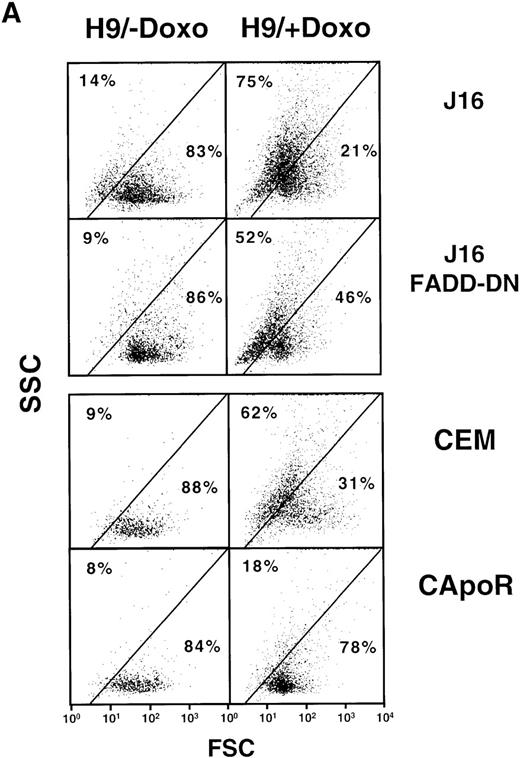
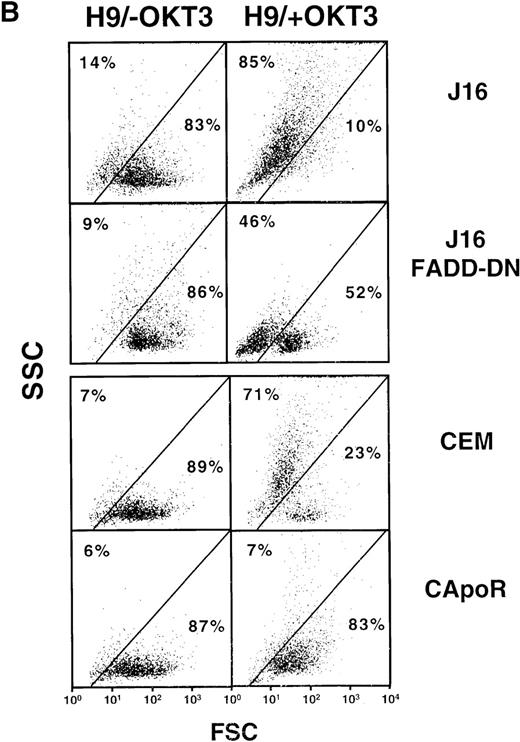
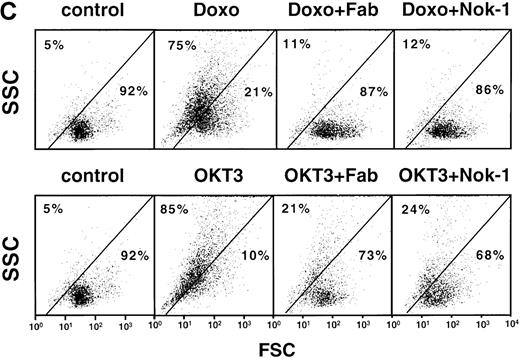
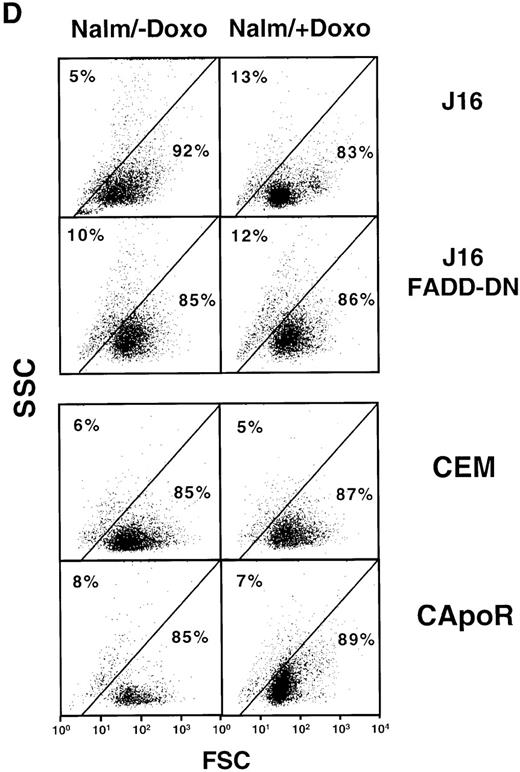
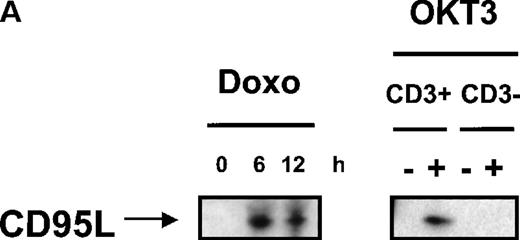
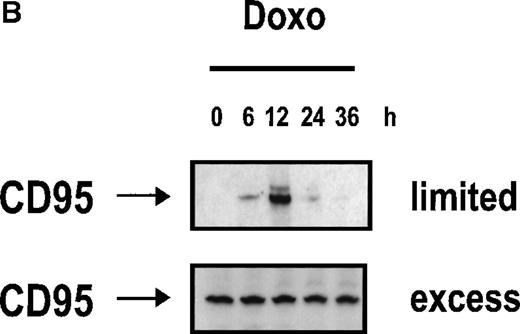

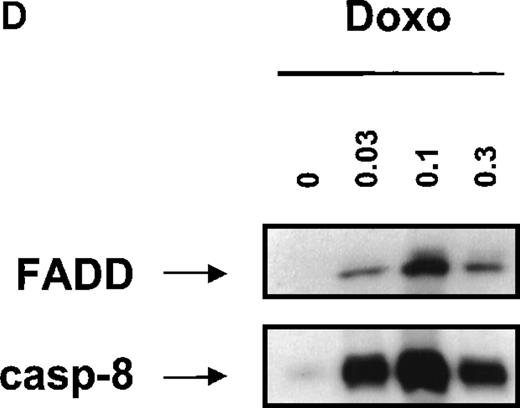
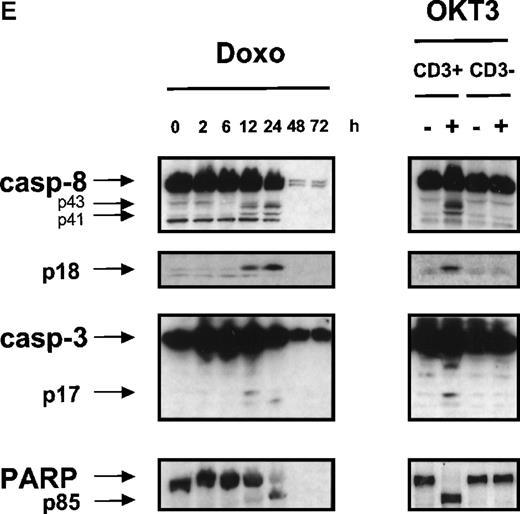


This feature is available to Subscribers Only
Sign In or Create an Account Close Modal